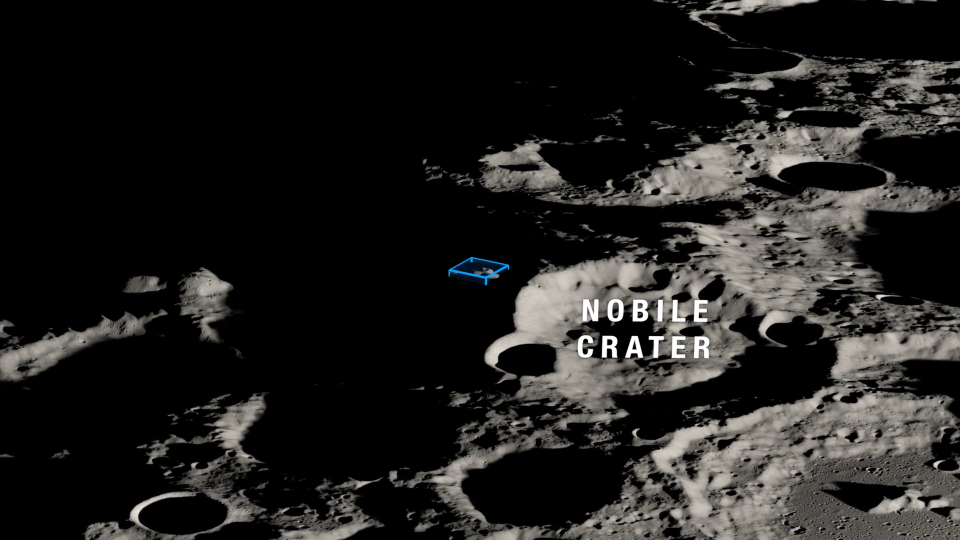COLORADO SPRINGS — Astrobotic’s next lunar mission will send not one but two rovers to Earth’s closest neighbor.
The Pittsburgh-based company plans to launch the Griffin lunar lander’s first mission atop a SpaceX Falcon Heavy rocket later this year. Griffin’s primary mission is to deliver NASA’s ice-chasing VIPER rover to the Moon’s south polar region, but on Monday, April 8, we learned the lander will also carry another, smaller rover.
Also hitching a ride on the Griffin-1 mission is Astrobotic’s CubeRover, a small modular machine designed to make lunar exploration accessible to a variety of customers. It will be operated using Spacefarer, a software platform developed by Canadian company Mission Control.
“What an exciting time in space exploration, as commercial companies are at the beginning of creating a new market economy on the moon,” Canadian Space Agency (CSA) chief Lisa Campbell said at a news conference here on Monday. At the 39th Space Symposium.
“This mission promises to be groundbreaking, a demonstration of commercial space technology,” he added. “But honestly, I think it’s going to grow from here.”
Relating to: Missions to the Moon: Past, present and future
Griffin will land on Mons Mouton, a flat-topped mountain about the size of Delaware.
The primary payload of the fixed lander is VIPER (Volatiles Exploring Polar Expedition Vehicle); Astrobotic received a $199.5 million contract from NASA’s Commercial Lunar Payload Services (CLPS) program in June 2020 to land VIPER safely on gray soil. (The contract is end-to-end, meaning Astrobotic was also responsible for the safety of the launch vehicle.)
Mons Mouton is near the moon’s south pole. This region is thought to be rich in water ice, which explains why NASA plans to establish a base in the region through its Artemis program. But it’s unclear how much ice actually exists near the south pole and how accessible it is; This is exactly where VIPER comes into play.
The 1,000-pound (450-kilogram) rover, which is about as big as a golf cart, will spend about 100 Earth days mapping the distribution and concentration of water ice in the Mons Mouton region.
“NASA will use the data the rover collects to show where ice on the moon can be found and where it is easiest to access, making VIPER the first resource mapping mission on another celestial body,” NASA officials wrote in a mission description. “The first resource maps of the Moon will take a critical step forward for NASA’s Artemis missions to establish a long-term presence on the lunar surface.”
Meanwhile, the shoebox-sized CubeRover will embark on a demonstration mission supported by CSA’s Lunar Exploration Accelerator Program. The small rover will deploy after VIPER and extend from Griffin to lunar soil on cables.
CubeRover will operate on the surface for one lunar day, which is equal to about two Earth weeks. If all goes as planned, it will conduct communications experiments with Griffin, shadow the lander to test its ability to cope with extreme thermal conditions, and demonstrate the capabilities of the Spacefarer operating platform on the moon for the first time.
According to Astrobotic, this first mission will be just the beginning for the CubeRover. The wheeled robot can be scaled up to accommodate larger payloads; Future versions could carry science instruments and other equipment around the moon and remain operational for a year or more, according to Mike Provenzano, Astrobotic’s vice president of advanced development programs.
“We are really excited about the opportunities this will bring to the industry.” [lunar business] ecosystem,” Provenzano said at Monday’s press conference.

RELATED STORIES:
— Who is Astrobotic Technology and what does it do?
— NASA’s ice chaser VIPER lunar rover prepares to slide toward the launch pad
— The Moon: Everything you need to know about Earth’s friend
Griffin-1 will not be Astrobotic’s first lunar mission. The company’s smaller Peregrine lunar lander launched Jan. 8 during the first liftoff of United Launch Alliance’s new Vulcan Centaur rocket.
The launch went well, but Peregrine experienced a problem with its propulsion system shortly after being deployed from the Vulcan Centaur’s upper stage. This problem doomed the lander’s planned lunar mission, also funded by CLPS; On January 18, Astrobotic guided Peregrine to a controlled destruction in Earth’s atmosphere.
Twenty payloads crashed with Peregrine, including Iris, a CubeRover-like robot developed by students at Carnegie Mellon University in Pittsburgh.
Astrobotic has revealed VIPER and CubeRover, as well as several other payloads that will fly on Griffin-1. Also on the rise are the European Space Agency’s LandCam-X landing camera system and NASA’s laser retroreflector. Company representatives said Monday that more cargo could be announced in the coming weeks and months.